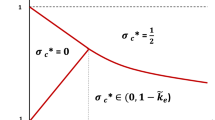Conclusions
In re-analyzing the Ferejohn and Fiorina (1974) examination of ‘rational’ abstention we found that admitting mixed strategies does not affect findings as to the optimal behavior of voters who are expected utility maximizers but does significantly affect our expectations as to behavior of voters using a minimax regret rule. We found that minimax regretters with admissible mixed strategies would always have some probability of voting rather than abstaining, except under the quite restrictive condition that c > 1/2. Thus, to the extent that some voters can be seen as operating from a minimax regret perspective, a decision to vote on their part can be understood without recourse to ideas like the ‘psychic benefits of voting’ or ‘citizen duty’.
An important difference between the Ferejohn and Fiorina (1974) analysis and our own is that their models all have step-function threshold effects, while ours is probabilistic in nature and behavior is gradient-like. In the usual rational choice modeling of voter behavior (including the minimax regret model restricted to the pure strategy case) voters behave deterministically: e.g. if p 3 + p 4 > 2c then expected utility maximizing voters always abstain in two-candidate plurality elections; if p 3 + p 4 < 2c then they always vote for their first choice. In the mixed strategy minimax regret model, on the other hand, raising c (or k) does not operate in a dichotomous fashion — instantaneously shifting the voter from voting to abstention once a critical threshold is passed. Rather, as c (or k) increases, the probability of voting decreases.
We believe that probabilistic choice mechanisms are more descriptive of human choice behavior (including voter behavior) than are deterministic ones. Thus, while the mixed strategy minimax-regret model we propose may only account for the behavior of some voters, we believe it is desirable to pursue other models for voter choice which, unlike those now current in the literature, do not postulate sharp ‘on-off’ effects but make use instead of response-gradient notions.
Similar content being viewed by others
References
Barzel, Yoram, and Silberberg, Eugene. ‘Is the Act of Voting Rational?’ Public Choice 16 (Fall 1973), pp. 51–58.
Brams, Steven. Game Theory and Politics. New York: Free Press, 1975.
Brody, Richard A., and Page, Benjamin, I. ‘Indifference, Alienation and Rational Decisions.’ Public Choice 15 (Summer 1973), pp. 1–10.
Downs, Anthony. An Economic Theory of Democracy. New York: Harper, 1957.
Ferejohn, John, and Fiorina, Morris. ‘The Paradox of Not Voting: A Decision Theoretic Analysis.’ American Political Science Review 68 (June 1974), pp. 626–535.
—, and —. ‘Closeness Counts only in Horseshoes and Dancing.’ American Political Science Review 69 (September 1975), pp. 920–925.
Grofman, Bernard. ‘An Introduction to Models of Individual and Collective Decision-Making.’ Unpublished Manuscript, School of Social Sciences, University of California, Irvine, 1976.
Luce, R. Duncan. Individual Choice Behavior. New York: John Wiley, 1959.
—, and Raiffa, Howard. Games and Decisions. New York: Wiley, 1957.
Mayer, Lawrence S., and Good, I.J. ‘Is Minimax Regret Applicable to Voting Decisions?’ American Political Science Review 69 (September 1975), pp. 916–917.
Riker, William H., and Ordeshook, Peter C. Introduction to Positive Political Theory. Englewood Cliffs, New Jersey: Prentice-Hall, 1973.
Settle, Russell F., and Abrams, Burton A. ‘The Determinants of Voter Participation: A More General Model.’ Public Choice 27 (Fall 1976), pp. 82–89.
Smith, Jeffrey W. ‘A Clear Test of Rational Voting.’ Public Choice 23 (Fall 1975), pp. 55–68.
Smith, Jeffrey W. ‘A Clear Test of Rational Voting.’ Public Choice 23 (Fall 1975), pp. 55–68.
Stephens, Steven V. ‘The Paradox of Not Voting: Comment.’ American Political Science Review (September 1975), pp. 914–915.
Tollison, R.D., and Willett, T.D. ‘Some Simple Economics of Voting and Not Voting.’ Public Choice 16 (Fall 1973), pp. 59–72.
Wolfinger, Raymond E., and Rosenstone, Steven J. ‘Who Votes?’ Paper prepared for delivery at the 1977 Annual Meeting of the American Political Science Association, Washington D.C., September 1–4, 1977.
Wuffle, A. ‘Should You Brush Your Teeth on November 4, 1980: A Rational Choice Perspective.’ Paper not delivered at the Conference on Voter Turnout, San Diego, May 16–21, 1979.
Author information
Authors and Affiliations
Rights and permissions
About this article
Cite this article
Grofman, B. Abstention in two-candidate and three-candidate elections when voters use mixed strategies. Public Choice 34, 189–200 (1979). https://doi.org/10.1007/BF00129526
Issue Date:
DOI: https://doi.org/10.1007/BF00129526




